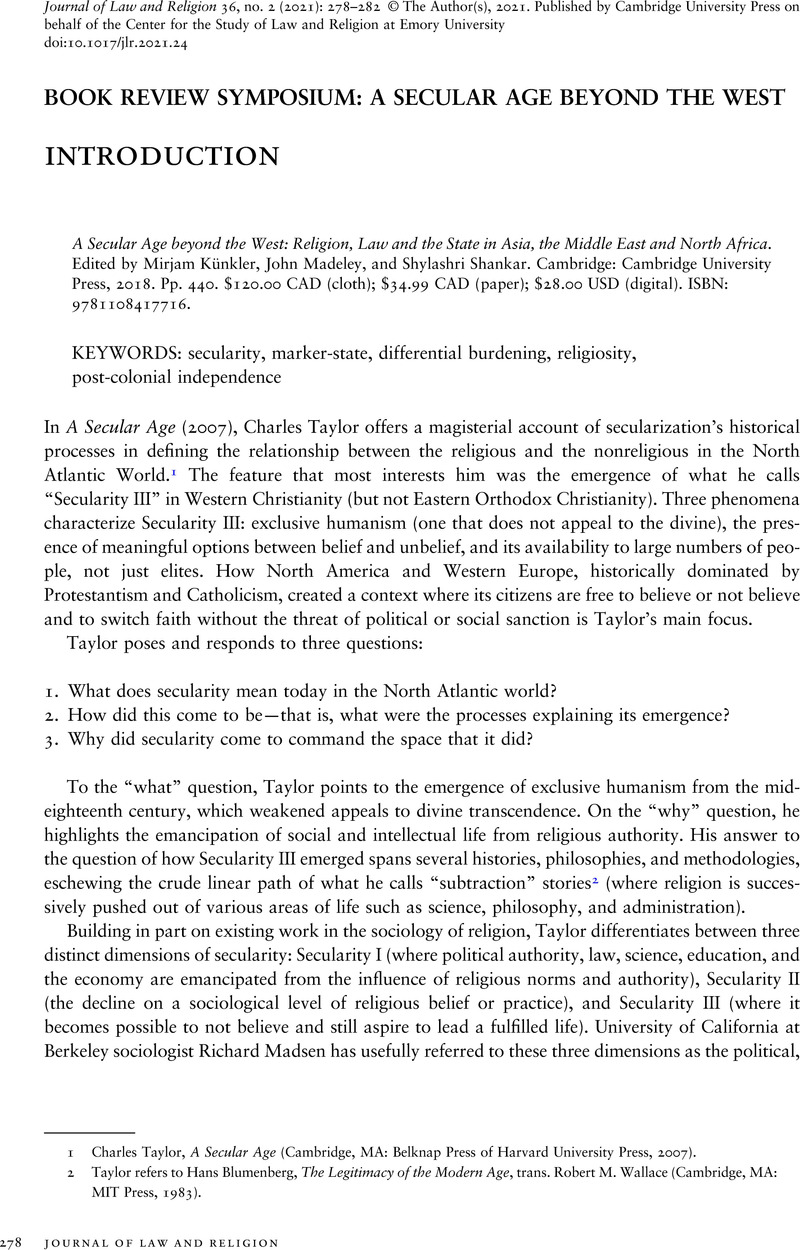No CrossRef data available.
Article contents
INTRODUCTION - A Secular Age beyond the West: Religion, Law and the State in Asia, the Middle East and North Africa. Edited by Mirjam Künkler, John Madeley, and Shylashri Shankar. Cambridge: Cambridge University Press, 2018. Pp. 440. $120.00 CAD (cloth); $34.99 CAD (paper); $28.00 USD (digital). ISBN: 9781108417716.
Published online by Cambridge University Press: 05 July 2021
Abstract

- Type
- Book Review Symposium: A Secular Age Beyond the West
- Information
- Copyright
- Copyright © The Author(s), 2021. Published by Cambridge University Press on behalf of the Center for the Study of Law and Religion at Emory University
References
1 Taylor, Charles, A Secular Age (Cambridge, MA: Belknap Press of Harvard University Press, 2007)CrossRefGoogle Scholar.
2 Taylor refers to Hans Blumenberg, The Legitimacy of the Modern Age, trans. Robert M. Wallace (Cambridge, MA: MIT Press, 1983).
3 Madsen, Richard, “Secularism, Religious Change, and Social Conflict in Asia,” in Rethinking Secularism, ed. Calhoun, Craig, Juergensmeyer, Mark, and VanAntwerpen, Jonathan (New York: Oxford University Press, 2011), 248–69Google Scholar.
4 Taylor, A Secular Age, 3.
5 The contributors, a group of political scientists, historians, sociologists, and scholars of religion and law, met regularly for nearly a decade. Our shared interests in examining the interplay between religion, law, politics, and history in Asia, Europe, and the Middle East produced exciting workshops in Florence, Istanbul, Onati, and Bellagio, and a six-month research group at the Centre for Interdisciplinary Research in Bielefeld, Germany.
6 Though a discussion of Secularity I cannot be separated from a state's policy of secularism, we, like Taylor, make a distinction between secularity and secularism. Secularism denotes the ideology that legitimates the separation of religious and political authority, the expulsion of religious law from the legal system, and sometimes even the exclusion of religion from the public sphere. Our cases illustrate that the relationship between secularism and Secularity I is complex, and the two phenomena often intertwine in counterintuitive ways.
7 Peter Berger writes that governments generally follow one of two strategies, fundamentalism and relativism, to tackle competing religious and non-religious beliefs. In several countries studied in our volume, governments instituted laws that sought to “restore” a moral and epistemic order through political means (fundamentalism). Relativism, making an ideology out of moral equivalence, nonjudgmentalism, and “tolerance,” was a path less likely to be followed. Peter Berger, The Many Altars of Modernity: Toward a Paradigm for Religion in a Pluralist Age (Boston: De Gruyter, 2014), especially 9–12. Fundamentalism has become even more prevalent in the shadow of a pandemic unleashed by Covid-19 when exclusionary ideologies have found willing ears among citizens wracked by insecurity and isolation.
8 Laliberté, André, “How Do We Measure Secularity?,” Journal of Law and Religion 36, no. 2 (2021)Google Scholar (this issue).
9 See Radhakrishnan, S., “The Ethics of the Vedanta,” International Journal of Ethics 24, no. 2 (1914): 168–83CrossRefGoogle Scholar; T. N. Madan, “Perspectives on Pluralism,” Seminar, no. 484 (1999); Bhargava, Rajeev, “An Ancient Indian Secular Age?,” in Beyond the Secular West, ed. Bilgrami, Akeel (New York: Columbia University Press, 2016), 188–214Google Scholar; Fisher, Elaine M., Hindu Pluralism: Religion and the Public Sphere in Early Modern South India (Oakland: University of California Press, 2017)CrossRefGoogle Scholar.
10 Ravitch, Frank S., “Religion as Culture in a Secular Age,” Journal of Law and Religion 36, no. 2 (2021)Google Scholar (this issue).
11 Selçuk Esenbel, “Reflections from Home on Secularism and the Possibility of Muslim Democracy,” Journal of Law and Religion 36, no. 2 (2021) (this issue).
12 David Martin pioneered this approach for Western Europe in A General Theory of Secularization (New York: Harper and Row, 1978). For Khan’s essay, see Khan, Amjad, “‘Secularity without Secularism’: The Case of Pakistan,” Journal of Law and Religion 36, no. 2 (2021)Google Scholar (this issue).
13 Robert W. Hefner's review of our volume in his talk, “Secularity and Religion-State Dynamics beyond the West,” panel presentation on New Directions in the Study of Comparative Secularity Across Asia, Association for Asian Studies Annual Meeting, March 22, 2021.
14 Six, Clemens, “Transnational Perspectives on a Global Secular Age,” Journal of Law and Religion 36, no. 2 (2021)Google Scholar (this issue).
15 Taylor, A Secular Age, 262–64.
16 An early example from 600 BCE India is Charvaka philosophy, which held that materialism is the only way to understand and live in the world.





